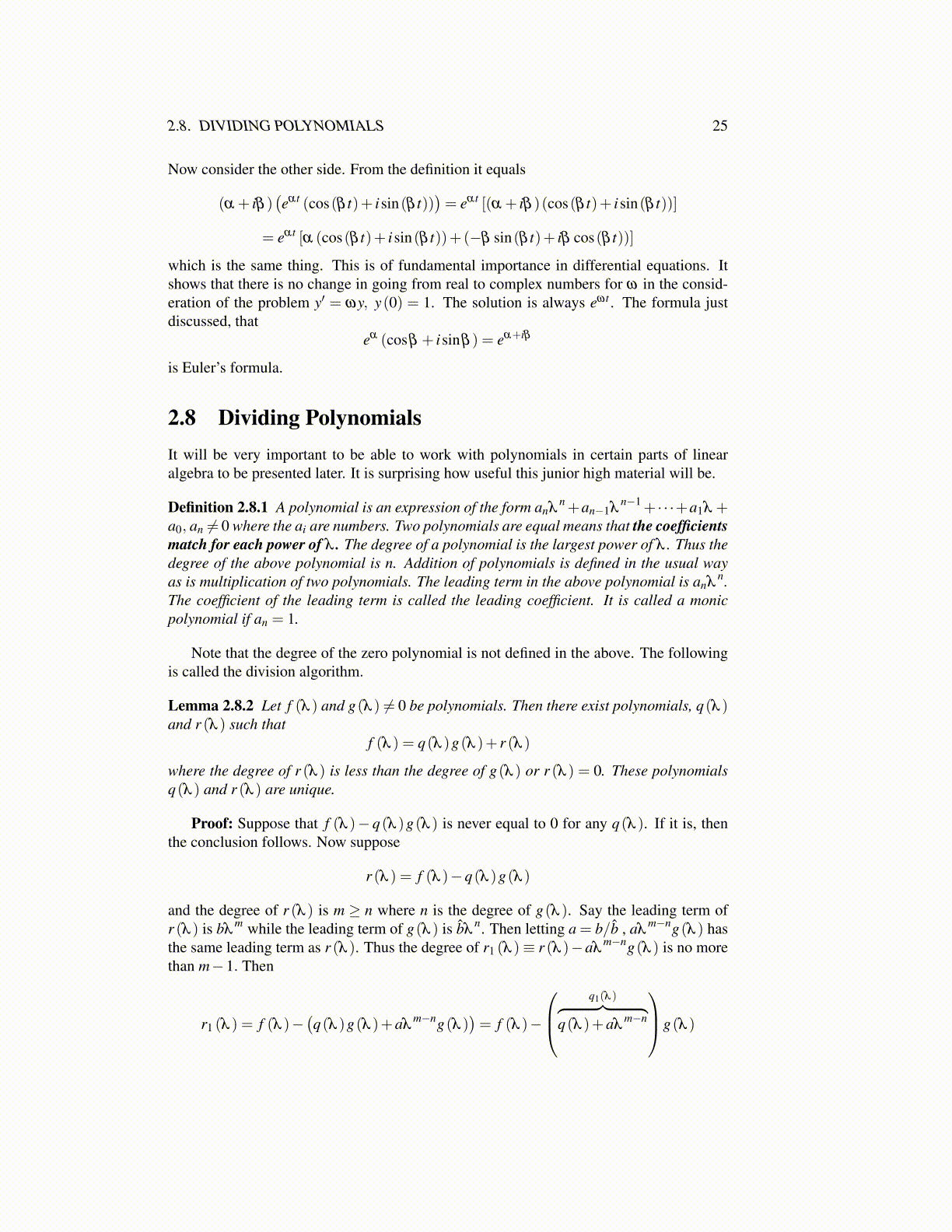
2.8. DIVIDING POLYNOMIALS 25
Now consider the other side. From the definition it equals
(α + iβ )(eαt (cos(β t)+ isin(β t))
)= eαt [(α + iβ )(cos(β t)+ isin(β t))]
= eαt [α (cos(β t)+ isin(β t))+(−β sin(β t)+ iβ cos(β t))]
which is the same thing. This is of fundamental importance in differential equations. Itshows that there is no change in going from real to complex numbers for ω in the consid-eration of the problem y′ = ωy, y(0) = 1. The solution is always eωt . The formula justdiscussed, that
eα (cosβ + isinβ ) = eα+iβ
is Euler’s formula.
2.8 Dividing PolynomialsIt will be very important to be able to work with polynomials in certain parts of linearalgebra to be presented later. It is surprising how useful this junior high material will be.
Definition 2.8.1 A polynomial is an expression of the form anλn+an−1λ
n−1+ · · ·+a1λ +a0, an ̸= 0 where the ai are numbers. Two polynomials are equal means that the coefficientsmatch for each power of λ . The degree of a polynomial is the largest power of λ . Thus thedegree of the above polynomial is n. Addition of polynomials is defined in the usual wayas is multiplication of two polynomials. The leading term in the above polynomial is anλ
n.The coefficient of the leading term is called the leading coefficient. It is called a monicpolynomial if an = 1.
Note that the degree of the zero polynomial is not defined in the above. The followingis called the division algorithm.
Lemma 2.8.2 Let f (λ ) and g(λ ) ̸= 0 be polynomials. Then there exist polynomials, q(λ )and r (λ ) such that
f (λ ) = q(λ )g(λ )+ r (λ )
where the degree of r (λ ) is less than the degree of g(λ ) or r (λ ) = 0. These polynomialsq(λ ) and r (λ ) are unique.
Proof: Suppose that f (λ )− q(λ )g(λ ) is never equal to 0 for any q(λ ). If it is, thenthe conclusion follows. Now suppose
r (λ ) = f (λ )−q(λ )g(λ )
and the degree of r (λ ) is m ≥ n where n is the degree of g(λ ). Say the leading term ofr (λ ) is bλ
m while the leading term of g(λ ) is b̂λn. Then letting a = b/b̂ , aλ
m−ng(λ ) hasthe same leading term as r (λ ). Thus the degree of r1 (λ )≡ r (λ )−aλ
m−ng(λ ) is no morethan m−1. Then
r1 (λ ) = f (λ )−(q(λ )g(λ )+aλ
m−ng(λ ))= f (λ )−
q1(λ )︷ ︸︸ ︷
q(λ )+aλm−n
g(λ )